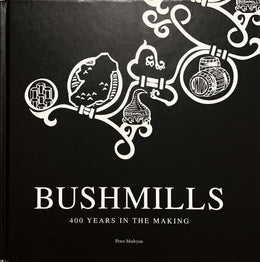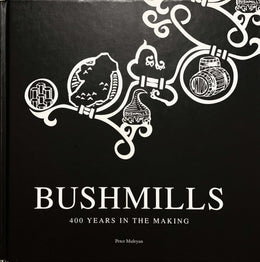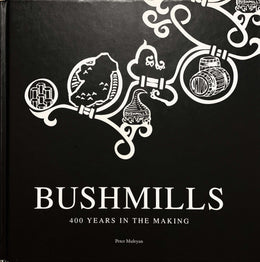Poitin didn't go away. In fact it is still possible to find a man, who knows a man, who knows a man, who will get a bottle for you. A decade after the 1823 Act, it was reported that: "poteen was sold in the streets as openly as a loaf of bread". But 1833 is interesting for another reason. This is the year we again find a record of legitimate distilling in Bushmills, when James McKibben is recorded as paying duty on 10,216 proof gallons.
McKibben's operation in Bushmills was tiny, and he served a very local market. Road links were still poor, and as late as 1827 the Ordnance Survey Memoirs refer to the town of Bushmills as "a collection of a few cabins of an inferior description..." However, the Survey does say that the makings of the fine modern town were under way:
“...owing to the exertions of the proprietor [of the town] Sir Francis Workman Macnaghten, who built the markets, stores...besides several good houses for persons in residence...The business and dealing in Bushmills is all increasing, the numbers who visit it on their way to the Giant's Causeway contribute not only to the support of the hotel keepers but also that of the dealers and guides...Sir Francis now having made Bushmills his fixed residence must from his large income and establishment, and the employment he afforded to artisans and labourers, contribute much towards its prosperity and improvement."
Indeed Sir Francis, 1st Baron of Dundarave, did make his home there, and his descendants still live in a house that overlooks the town of Bushmills. By any reckoning Sir Francis Workman Macnaghten was an amazing character.
The Annual Register 1843 notes the death of Sir Francis and records the following impressive detail:
"It is remarkable that he continued a bachelor until he reached the eighty-second year of his age, when he resolved to marry....the fruits of this marriage were two sons, both of whom he lived to see of age."

You can't help but wonder if it had anything to do with the local whiskey.
At this early stage distilleries were modest affairs, which often came and went with the seasons. In 1835 James McKibben is recorded as the only licensed distiller in the town of Bushmills, but he is then joined by a second operation between 1840 and 1845. It is pretty certain that 1845's The Parliamentary Gazetteer of Ireland is referring to McKibben's distillery, when it describes Bushmills town:
"[It is] a neat and improving place...it contains several places of worship; a court house, a commodious hotel and posting establishment, for the use of visitors to the Causeway, a small factory for spades and shovels; and a large well-known distillery." This reference, coupled with a mention in Slater's Directory of 1846, which notes Mr McKibben's "extensive distillery" clearly shows that his operation was of a relatively permanent nature.
But this development at Bushmills has to be seen in the context of what was happening in the rest of Ireland. The changing of the Excise laws gave the Irish industry a massive boost. This is the beginning of Irish whiskey's golden period. Large industrial distilleries were being established in Dublin and Cork, which dwarfed anything in Scotland. By 1825 the Midleton distillery had installed the largest pot still ever used in Ireland. It could hold 31,500 gallons, more than McKibben could produce in an entire year. Across the land business was booming. According to The Distillers Company report from the late 1850s: "The demand for Irish whiskey is practically unlimited at present".
Dublin, Cork and to a lesser extent Belfast were all well served with transport links. The Grand Canal now reached from Dublin to the river Shannon; this allowed whiskey to be transported easily and also allowed for raw ingredients to be accessed cheaply and easily. In contrast Bushmills was isolated from ports and at that stage a rail link.
The whiskey business was concentrated in Dublin and Cork, and these massive distilleries lubricated the Great British Empire. The behemoth plants of Roe's, Jameson and Powers, with their cooperages and copper works were spread across huge chunks of land right in the centre of the capital. These plants and Murphy's of Cork had massive economies of scale, dwarfing anything else in Ireland or Scotland.
In 1850 the combined output of the distilleries in Drogheda was a not inconsiderable 1.25 million gallons, yet thirty-four years later there was no one making whiskey in the town. The Dublin giants had crushed the Drogheda distillers. The number of distilleries in Ireland fell from 90 to 51, in the ten years between 1837 and 1847. As the small regional plants closed, their business was taken by the urban giants. At their peak in the late Victorian era, Andrew Watt in Londonderry and George Roe of Dublin produced —between them —more than all of the rural distilleries put together.
The world was changing and small operations like the distillery in Bushmills were finding it harder and harder to stay afloat. Then there was Aeneas Coffey, the Excise man with a bayonet wound in his leg.
Written by Peter Mulryan
The text is an excerpt from "Bushmills: 400 Years in the Making" (pp. 30 - 31), written by Peter Mulryan, published 2008 by Appletree Press Ltd.







